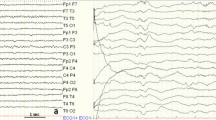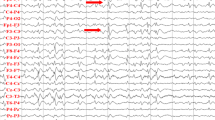Abstract
Toxic honey, containing grayanotoxin, is obtained from nectar and polen of rhododendron. Consumed in excess it produces seizures and convulsions. In order to investigate whether the toxic honey extract can be used as a seizure model, we examined the electroencephalographic (EEG) and motor effects of intracerebroventricular (icv) or intraperitoneal (ip) injection of toxic honey extract in Wistar rats or in genetic absence epilepsy rats from Strasbourg (GAERS). Male Wistar rats or GAERS were stereotaxically implanted with bilateral cortical recording electrodes in all ip groups and cannula in the icv groups. Based on the previous study, an extract was obtained from the non-toxic and toxic honey. After the injection of the non-toxic or toxic honey extract, seizure stages and changes in EEG were evaluated from 9 am to noon. The icv administration of toxic honey extract produced stage 4 seizures and bilateral cortical spikes within 30–60 min and these effects disappeared after 120 min in Wistar rats or GAERS. The mean of bilateral cortical spike acitivity in EEG of Wistar rats was 804.2 ± 261.0 s in the 3-h period. After the icv administration of toxic honey extract to GAERS, the mean duration of spike-and-wave discharges (SWDs) in GAERS significantly decreased during the first 60 min and then returned to baseline level. Ip injection of toxic honey extract caused no seizure and no change in EEG in either GAERS or Wistars. These results suggest that the icv administration of toxic honey extract can be used as a seizure model.



Similar content being viewed by others
References
Onat FY, Yegen BC, Lawrence R (1991) Mad honey poisoning in man and rat. Rev Environ Health 9(3–92):4
Dubey L, Maskey A, Regmi S (2009) Bradycardia and severe hypotension caused by wild honey poisoning. Hellenic J Cardiol 50:426–428
Avcı M (2004) Rhododendrons and their natural occurrences in Turkey. Istanb Üniversitesi Edebiyat Fakültesi Coğrafya Bölümü Coğrafya Dergisi 12:13–29
Yuki T, Yamaoka K, Yakehiro M, Seyama I (2001) State-dependent action of grayanotoxin I on Na+ channels in frog ventricular myoctes. J Physiol 534:777–790
Onat FY, Yeğen BC, Lawrence R, Oktay A, Oktay S (1991) Site of action of grayanotoxins in mad honey in rats. J Appl Toxicol 11(3):199–201
Benke TA, Swann J (2004) The tetanus toxin model of chronic epilepsy. Adv Exp Med Biol 548:226–238
Juhng KN, Kokate TG, Yamaguchi S, Kim BY, Rogowski RS, Blaustein MP, Rogawski MA (1999) Induction of seizures by the potent K+ channel-blocking scorpion venom peptide toxins tityustoxin-K (alpha) and pandinustoxin-K (alpha). Epilepsy Res 34(2–3):177–186
Poon WT, Ho CH, Yip KL, Lai CK, Cheung KL, Sung RY, Chan AY, Mak TW (2008) Grayanotoxin poisoning from Rhododendron simsii in an infant. Hong Kong Med J 14(5):405–407
Dilber E, Kalyoncu M, Yarış N, Ökten A (2002) A case of mad honey poisoning presenting with convulsion: ıntoxication ınstead of alternative therapy. Turk J Med Sci 32:361–362
Racine RJ (1972) Modification of seizure activity by electrical stimulation II. Motor seizure. EEG Clin Neurophysiol 32:281–294
Danober L, Deransart C, Depaulis A, Vergnes M, Marescaux C (1998) Pathophysiological mechanisms of genetic absence epilepsy in the rat. Prog Neurobiol 55:27–57
Coenen AM, van Luijtelaar EL (2003) Genetic animal models for absence epilepsy: a review of the WAG/Rij strain of rats. Behav Genet 33:635–655
Paxinos G, Watson C (1998) The Rat Brain in Stereotaxic Coordinates, 4th edn. Academic Press, San Diego
Gunduz A, Aydin M, Akca M, Turkmen S, Turedi S, Eryigit U, Cansu A, Yildirim M (2012) Is grayanotoxin directly responsible for mad honey poisoning-associated seizures. Turk J Med Sci 42(6):1086–1092
Onat FY, Aker RG, Gurbanova AA, Ates N, van Luijtelaar G (2007) The effect of generalized absence seizures on the progression of kindling in the rat. Epilepsia 48:150–156
Carcak N, Aker RG, Ozdemir O, Demiralp T, Onat FY (2008) The relationship between age-related development of spike-and-wave discharges and the resistance to amygdaloid kindling in rats with genetic absence epilepsy. Neurobiol Dis 32:355–363
Gurbanova AA, Aker RG, Sirvanci S, Demiralp T, Onat FY (2008) Intra-amygdaloid injection of kainic acid in rats with genetic absence epilepsy: the relationship of typical absence epilepsy and temporal lobe epilepsy. J Neurosci 28(31):7828–7836
Acknowledgments
This study was supported by the Marmara University Scientific Research Committee.
Author information
Authors and Affiliations
Corresponding author
Rights and permissions
About this article
Cite this article
Kuru, P., Torun, M., Halac, H.M. et al. Electroencephalographic and behavioral effects of intracerebroventricular or intraperitoneal injections of toxic honey extract in adult Wistar rats and GAERS. Neurol Sci 35, 1903–1908 (2014). https://doi.org/10.1007/s10072-014-1858-6
Received:
Accepted:
Published:
Issue Date:
DOI: https://doi.org/10.1007/s10072-014-1858-6




